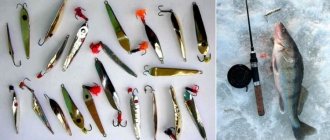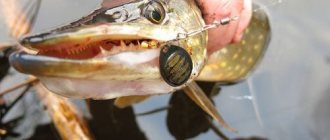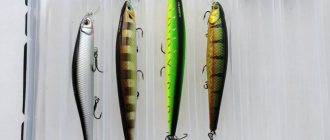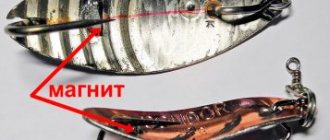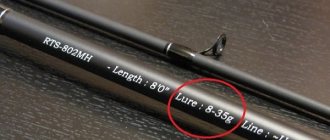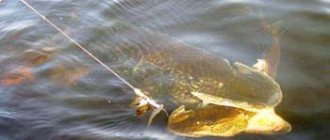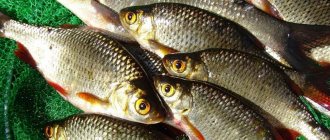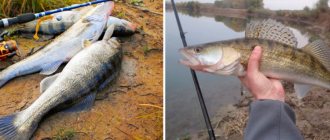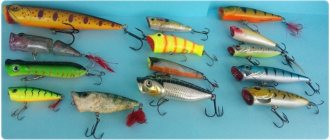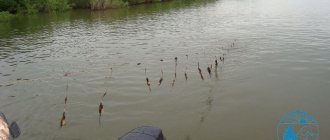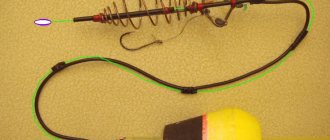How to fish with a lure correctly? Types and rules when choosing
So, you have already chosen a good quality spinning rod for fishing, you are in a great mood and aim to return home only with a large amount of catch.
However, if you miss the right choice of bait, the whole trip risks turning into a waste of time and effort when the fish will bypass your hook a mile away.
As for spinners, the range is really extensive, and among all the variety, it will be quite difficult for a novice fisherman to give preference to one or another bait without first explaining what a spinner is and what the principle of its operation is.
What is a spinner?
In the fishing community, a spinner is usually called a type of bait, which is characterized by the presence of one or several hooks, and with the help of its appearance creates an imitation of a small fish or insect.
It usually looks like a small metal petal and comes in a variety of colors.
The principle of operation of such bait is to produce certain vibrations and flashes under water, with the help of which the fish are carefully lured onto a hook thrown into its habitat.
Among the variety of models presented, in order to purchase exactly the option that will most satisfy all the tasks at hand, it is necessary to consider in more detail all existing types of this bait.
These include the following types:
Oscillating spoons
Based on the name, you can understand that the operating principle of this bait consists of oscillating movements , to which any predatory fish actively reacts.
Thus, by performing such vibrations, a fairly believable imitation of a small fish is created, attracting the attention of prey with the shine of its metal plate.
On one side of such a spoon a hook is attached using a swivel, and on the opposite side - a fishing line. The use of this type of bait in the autumn may appeal to all predatory fish, which react very actively to oscillating bait before the start of winter.
Spinners
Among fishermen you can also find such a name as turntables. Such models are distinguished by a rather complex design , consisting of a five-centimeter rod, which is attached to the leash using a winding ring on one side.
Hooks, an anchor and other devices are already attached to the other end. Thanks to its rotational movements, this lure quickly attracts predators and forces prey to fall on your hook.
Spoon jigs
A distinctive feature of such artificial bait is the presence of a certain cylindrical shape , and its use is most often aimed at casting fishing.
Spinner “not hooked”
Its main secret was a special manufacturing technique , thanks to which the hook is securely hidden under a metal mesh and comes out only when the fish swallows the bait inside.
It is this technique that helps the fisherman avoid any snags that negatively affect the quality of the gear used.
Kinds
Among the variety of models presented, in order to purchase exactly the option that will most satisfy all the tasks at hand, it is necessary to consider in more detail all existing types of this bait.
Oscillating spoons
Based on the name, you can understand that the operating principle of this bait consists of oscillating movements, to which any predatory fish actively reacts. Thus, by performing such vibrations, a fairly believable imitation of a small fish is created, attracting the attention of prey with the shine of its metal plate. On one side of such a spoon a hook is attached using a swivel, and on the opposite side - a fishing line. The use of this type of bait in the autumn may appeal to all predatory fish, which react very actively to oscillating bait before the start of winter.
Spinners
Among fishermen you can also find such a name as turntables. Such models are distinguished by a rather complex design, consisting of a five-centimeter rod, which is attached to the leash using a winding ring on one side. Hooks, an anchor and other devices are already attached to the other end. Thanks to its rotational movements, this lure quickly attracts predators and forces prey to fall on your hook.
Spoon jigs
A distinctive feature of such artificial bait is the presence of a certain cylindrical shape, and its use is most often aimed at casting fishing.
Spinner “non-hooking”
Its main secret was a special manufacturing technique, thanks to which the hook is securely hidden under a metal mesh and comes out only when the fish swallows the bait inside. It is this technique that helps the fisherman avoid any snags that negatively affect the quality of the gear used.
Which one and how to choose?
When purchasing the spinner you need, you should rely on the following rules that will help you choose the most suitable option:
- Before giving preference to any species, you should decide what predator your bait will be aimed at and under what weather conditions you are planning your trip.
- If the water in the reservoir is quite cloudy, it is better to use spinners with a characteristic, more intense shine.
- Baits with an overly polished metal surface should be avoided, because such blinding reflections in the water will only frighten your prey.
- If the weather promises to be clear and the water is clear, then you can take with you matte versions of spinners with detailing in the form of scales.
- When targeting perch or pike perch, you should opt for smaller baits, but if you want to get a pike on your hook, you should give preference to fairly large spoons.
- Beginning fishermen should not divert their attention to the huge number of products on offer, but it is best to opt for the fluctuating options of spinners, which will be easiest for a beginner to handle.
Assembling your first spinning rod: what novice anglers need to know
The spinning rod must meet certain criteria, depending, first of all, on the expected mass of the prey. When choosing a fishing rod and bait, it is important to take into account the fishing conditions, namely the characteristics of the reservoir and the distance over which you plan to cast the bait.
Also, when buying tackle, pay attention to the length, test and action of the rod. Fishermen with experience say that no less important is the choice of the appropriate weight of the reel to balance the purchased form, as well as the choice of cord and accessories.
Lure and line/braid test
The test determines the class of the fishing rod. Rods with a high test rating are distinguished by their power. Using such gear you can go hunting for trophy specimens.
The higher the blank test, the larger the bait can be used for fishing. The test is directly related to the power of the spinning rod. The ratio can be seen in the table:
Construction of a spinning blank
The gear structure can be: fast, medium, slow. For catching perch, chub, ide, medium-sized pike up to 2-3 kg and other small and medium-sized freshwater fish, a rod with a fast action is suitable.
When going for trophy specimens of pike, asp, and perch, you should take with you a spinning rod with a medium or fast medium action. If you plan to catch particularly large prey, such as catfish, it is better to use gear with a slow action.
Rod build
Rod length
A spinning rod, the length of which reaches 3 - 3.6 meters, is perfect for making long casts. If you plan to fish on small lakes or stakes, as well as small rivers, it is worth purchasing a form up to 2 meters long, maximum 2.5 meters.
Advice! For beginners, gear with a fast action, the length of which is in the range of 1.8-2.2 meters, is suitable.
How to catch?
Not only the type of fish caught, but also the quantitative content of your catch will depend on the correctness of the chosen fishing technique.
Pike fishing
For a successful hunt for this live bait, you should take the following tips into account:
- It is better to choose a rod with a length of 2.10-2.40 m, the test of which would be size 5-20.
- Any inertia-free reel will do, and it is better to choose a fishing line based on 0.25-0.28 mm in diameter.
- As for the spinner, in this case you should opt for oscillating models.
- During the fishing process, the bait is lowered to the bottom, then using the tip of a spinning rod, the spoon is lightly tossed and a fairly slow retrieve is performed.
Blitz tips
- If you are afraid of a possible snag, you should still not move the bait at too high a speed.
- It is most effective to carry out a slower wiring, making short stops.
- You should not cast your bait over a long distance, because most of the predators are mainly located in close proximity to the shore;
- When choosing a spinner, it is better to give preference to multi-colored options rather than opting for plain models of such bait;
- It is best if you choose those types of spinners, thanks to which you have already had a good quantitative catch;
- When using a “spinner”, you should stop such a bait for a few seconds during the retrieval process in order to mislead your prey, and thereby make the predator think that its prey has become quiet and wants to attack.
We assemble universal and ultralight spinning rods using the same scheme, but with different results
Beginning fishermen do not always understand how to assemble their first spinning tackle, where to start and where to start. Using the step-by-step guide for assembling a universal spinning rod, you can avoid mistakes:
- The knees of the tackle are joined so that the rings are located on the same line.
- A reel is mounted on the rod.
- The braid is passed through the rings and fixed to the reel. The cord is wound and secured, leaving a small side (2 mm).
- Install a leash; the choice of a specific leash depends on the type of gear and the fish being caught.
Titanium leashes are one of the options for leash material used for pike - After this, tie a swivel or fastener and attach the bait.
How to tie a swivel to a fishing line
If you plan to fish for pike, you should additionally tie a titanium/tungsten leash equipped with a carabiner.
Complete spinning rod equipment for pike fishing schematically
How to fish with a spinner - selection criteria
A good fisherman is a competent fisherman who, for fishing, selects not only a high-quality spinning rod, but also a good spinner, which the fish actively bite on.
For effective fishing, it is necessary to select high-quality gear and analyze the features of the reservoir where fishing is planned. Fishing stores offer a huge assortment of spinners, so choosing the ideal option that will suit the color palette, dimensions and material will not be difficult.
How to fish with a lure - the secrets of successful fishing
- In order to understand which lure is best to work with, you need to outsmart at least one fish. After catching, you need to cut open her womb and see what’s inside, what she’s been eating lately. The fate of further fishing depends on the knowledge gained. Now you can more accurately select the appearance of the spoon for a given area.
- It is not recommended to select very bright baits. In good weather, the sun's glare can harm the bite. The fish will get scared and swim away. Bright lures are made from steel and zinc.
- Fishing on a boat expands the fisherman's capabilities. With the help of a boat, you have a chance to swim from point to point, throwing a spinning rod in different places.
- You should pay close attention to the characteristics of the fishing rod. Fishing with a very rough reel handle will take all your strength to twist the handle. The reel stroke should be soft and easy.
- The sharpness of the hooks is of great importance. The chances of catching a fish on a blunt hook are greatly reduced.
- It makes sense to think about what the fish eat seasonally. In the summer, you can see a dragonfly, mosquito, larva, and beetle near the water. As an option, try to catch an insect or purchase it at a specialized store. Such insects are made from scrap materials (beads, feathers, springs, bottle caps).
- Instead of a spinner, a handful of worms and small fish are used for wiring. The fish are caught in the same reservoir, used instead of spoons, and you don’t mind losing them.
- The fisherman gains experience from his observations. If you keep short notes about fishing, indicating the area, fish, time, season, then you can come to certain conclusions about the habits of the fish.
- A good spinning bait is also made from tin (beer cans, tin cans).
- Pheromone additives will attract fish, increasing their hunger. The feathers will hide the hooks from the fish.
- Change lures, try different options!
Catching predatory fish with a spoon is, first of all, an exciting process, a hobby that is difficult to give up. And if all the nuances are taken into account in time, then a good result is guaranteed. Fishing stores offer a huge selection of lures made from different materials. You can also try to cast such a product yourself from silver, zinc, metal, aluminum. Predatory fish take best on matte white material; it attracts attention better at depth and scares off fish less.
sovetclub.ru
What is a spinner
In the fishing world, it is customary to call a spinner a type of bait that has from one to several hooks and which outwardly imitates a small fish or insect.
Outwardly, it resembles a metal petal and can be painted in any color palette.
The principle of the spinner's operation is as follows - when cast by a fisherman, it creates a certain vibration under water and sparkles, which especially attracts fish that are located in the area into which the cast was made.
Main types
In a fishing store, thanks to the huge assortment of spinners, it will not be difficult to choose exactly the model that will ideally meet all the requirements. Selecting a product is not difficult, but in order not to make a mistake with your choice, you should carefully study the main types of bait.
Hesitating
The basic operating principle of the product consists of oscillating movements, to which the fish that live very close to the casting site react. Thus, thanks to this design, a fairly believable imitation of a small fish is created, which attracts the attention of the prey with the shine of the metal plate and sounds.
Due to the swivel, a hook is attached to one side of this design, and a fishing line to the other side.
This type of bait is ideal for autumn and will especially arouse the interest of predatory inhabitants, who, before the start of the cold season, quite actively peck at the oscillating bait, confusing it with fish.
Rotating
The abbreviation “spinner” is especially common in the fishing world. The model has a very complex design, which consists of a rod measuring 5 centimeters, which is fixed to the leash by means of a winding ring. From the other edge, hooks, anchors and other devices are attached to the product.
Once in the water, the spoon begins to perform rotating actions that attract the attention of the fish and provoke it to bite.
Spoon jigs
The design has a cylindrical shape and this is its distinctive feature. The use of a spinner-bait is in fishing, carried out by casting it into a reservoir.
“Unhooked”
This type has a unique manufacturing technique, due to which the hook is firmly hidden under a metal mesh. And it comes out only at the moment when the fish begins to bite the spoon - this technique is unique in its content. Thanks to this technology, the fisherman, at the time of casting, does not have to worry about the likelihood of snags, which negatively affect the quality of the gear used for fishing.
Criteria for choosing the right spinner
When choosing a spoon for fishing, you need to rely on some criteria that will help you choose a more suitable option:
- Before you start making your choice, you need to decide which predator the bait is aimed at and under what weather conditions you plan to fish.
- If the water in a pond has a cloudy tint. It is best to select a spinner with a characteristic enhanced shine.
- Even the most attractive spoons with a polished metal surface should be avoided, since in the water they can only scare off the inhabitants with their too strong shine.
- If the reservoir where you plan to fish boasts clear water, and the fishing itself will take place in clear weather, then it is best to take with you matte spoons with scale detailing, which are sure to attract the attention of a potential victim.
- If you plan to fish for perch, then it is best to take smaller baits with you to the pond, and if you plan to catch pike, then it is better to choose large spoons, which are ideal for such predatory fish.
- It is best for beginners to pay attention to oscillating spoons, which will not be difficult for him to handle.
Lure fishing in summer
In summer, three types of lures are used to catch predatory fish (pike, pike perch, perch):
- sheer,
- to the track and
- spinning rod
Sheer trolling is advisable when there is abundant aquatic vegetation, which poses insurmountable obstacles for the other two types of fishing. Sheer trolling is also used in the fall, when fish begin to gather in holes and become less active.
A few words about spinner control. Controlling a spinner means “putting” the spinner where you want and leading the spinner where you want and how you want. To do this, it is not enough to have good command of the tackle; it is necessary that the design of the spinner itself ensures long and accurate casting, i.e. had a small windage, fell on the water before the load, or at least simultaneously with it, and made it possible to fish any layers of water, while maintaining its characteristic specific course, or, as they say, “game”. If the lure does not obey the angler, despite all his skill and experience, it is considered uncontrollable. It also happens: the spoon is chosen correctly, but in the water it does not give proper play, possible reasons for which are:
- incorrect (distorted) spinner model;
- distortion of the spinner during stamping;
- violation of the bending shape;
- incorrect or careless equipment, overloading the spoon with hooks, etc.
The spinner turns out to be uncontrollable here too, i.e. it does not serve as bait.
When choosing a spinner, you need to understand what the purpose of the spinner is, i.e. for what fishing conditions this or that spinner is intended. The less convex the spinner, the narrower and longer it is, the more streamlined it is. The thicker and more streamlined the spinner, the better it is. less mobile. Sedentary spinners are used either in very fast currents or require fast retrieval. The deeper the body of water with a fast current, the heavier and more streamlined the spoon should be. In all cases, the spinner should have a thickness and shape that would provide it with proper play, as close as possible to resembling a living creature.
You can read more about sheer trolling in the material Sheer trolling
It makes sense to fish on the track in reservoirs with a depth of over 5-6 m and with a relatively flat bottom.
Spinning fishing is possible in all bodies of water, both from the shore and from a boat. The best place for fishing with a spinning rod should be considered a depth of 2-4 m, with frequently changing bottom topography, where fishing with a track is not very convenient.
On lake-type reservoirs, as a rule, they use a boat. You can find an area of fish accumulation, especially in an unfamiliar body of water, using a path. In places where there are frequent bites, they linger and resort to spinning.
In rivers you can also fish from the shore, although the presence of a boat expands the angler’s options.
But let’s say that a spinning angler comes to a river that can be blocked by casting. Is a boat needed in such a situation? To answer this question, let's look at several cases of fishing. Figure 1 shows a section of the river when it is advantageous for a spinner to be on the shore rather than in a boat. However, such conditions are not that common. More often we come across the nature of the reservoir depicted in Figure 2.
Here the shallows are located not perpendicular, but parallel to the shore. As a rule, fish accumulate on the dumps of the shallows. Moving by boat to points 1-2-3, it is easy to fish the desired areas. Compare how narrowed the capabilities of a spinner fishing from the shore from positions 5-6 are. Let's pay attention to position 4 and casting from this position. The spinner, of course, will be able to “drag” the spoon over the underwater shallows shown in the figure, but it is impossible to make the correct retrieve, and the bite will only be accidental.
Let's take another, frequently encountered character of a reservoir (Fig. 3). According to the depths and underwater vegetation, the zone of fish accumulation will stretch parallel to the shore (shaded in the figure; the bold line indicates the boundary of the shallows and the depth - “dump”). Let's assume that this zone will be 8-10 m from the dump, and its width will be 4-5 m. Outside this narrow and long strip, bites are random. The figure shows how unfavorable the positions of a spinner standing on the shore (1-7) are compared to a spinner in a boat (8-10). To fish this zone, a spinner from the shore must make 20-25 casts, and a spinner from a boat must make 3-4 casts. At the same time, his lure will pass its entire path in the area where fish accumulate, and the lure of the one standing on the shore will pass most of the way in empty space.
However, the boat should also be used wisely. We often see how an angler, moving parallel to the reeds at a distance of 20-25 m, “throws” the spoon to the edge of the reeds (Fig. 4). In this case, the spinning rod “hits the pike on the head,” frightening the predator standing in the reeds. In addition, the lure will travel 80% of the way in vain, since, as it approaches a boat in a deeper place, it moves away from the bottom.
By moving on a boat along the reeds and leading the lure parallel to the reeds, you can count on a good catch with fewer casts. However, at the same time, greater casting accuracy is required from the spinning angler: the spoon must be placed no further than 0.5-1.5 m from the edge. If the angler holds the lure further from the edge, then a bite is out of the question.
The initial casts do not need to be made far. Long casts can be less accurate; in addition, when biting on a long cast, the caught fish will scare away predators standing closer to the boat. It is recommended to make the first cast no further than 15-18 m, the second - 20-25, the third - 25-35 m. After this, the boat should be moved forward to the distance of the third cast - and start fishing again.
In general, it is convenient to fish such areas with two people: one slowly leads the boat stern first, the other, standing at the stern, casts as the boat moves. At the moment the spoon comes into contact with the water, the rower slows down the boat, and the catcher holds the spoon parallel to the edge of the reeds. After two or three trips in this zone, regardless of the bites, the boat is moved forward to an unfished area.
When fishing with a spinning rod, the boat must be light, moveable and fairly stable.
In conclusion, about fishing from the shore. Spinners often choose areas that are most convenient for casting. From such “convenient” positions, the fish is either caught or has already been “strung” with a spoon, especially in reservoirs near large cities. Therefore, you should choose positions that are obviously inconvenient for casting, for example, wade through the thick of bushes, make short casts under thickets hanging over the water, etc., in other words, fish where most anglers do not risk doing this. You can also get here by boat.
P. YURKEVICH
How to catch pike with a spoon
To ensure that catching this predator does not turn into trouble, you need to focus on some tips:
- For fishing, it is best to take a rod whose length is 2.10-2.40 meters and a test rod of size 5-20.
- You can choose any spinning reel, and it is better to select a fishing line based on 0.25-0.28 mm in diameter.
- The selection of spinners does not have strict restrictions, but it is best to give preference to oscillating models.
- During the fishing process, you need to lower the bait to the bottom and then, using the tip of the spinning rod, lightly toss the spoon and perform a slow retrieve.
How to catch asp with a spoon
Catching this fish requires special patience and strength from the fisherman, because catching it is sometimes not so easy, since, once hooked, it can offer very strong resistance, which some amateurs are sometimes unable to cope with. So, for such fishing you should also adopt a couple of useful tips:
- It is best to give preference to a spinning rod up to 3 meters long, the test of which does not exceed 70.
- The diameter of the fishing line should be 0.2-0.25 mm.
- It is better to fish with spoons weighing from 30 to 45 grams.
- A distinctive feature of the asp fishing technique is that the process is carried out using surface technology, when the wiring passes to the very surface of the reservoir.
How to catch fish with a spoon - fishing technique
- First you need to choose a bait and securely tie it to the fishing line. Since the fish at some point strongly tugs the bait and can tear the fishing device. Strong and reliable knots are used, such as a double knot for regular fishing line and a palamar for braided fishing line. By using braided fishing line, a fisherman reduces the chances of the line breaking as it is strong and does not stretch.
- When pulling oscillators or spinners through the water, the reel operates smoothly but confidently. When working with a jig, jerkily - move, break, move, etc.
- Accuracy will not hurt when throwing gear from the shore. Trees, bushes, and reeds growing nearby can interfere. Also, more than once the person himself was caught on the hook. It is worth examining the area very carefully and be sure to look up. Good casting is often hampered by branches that are within the casting path.
- If the fishing line still gets stuck in algae or is wrapped in underwater snags, then, first of all, you need to remember this place. Then try to pull out the line, gently pulling the rod to the side and up. You can try to pull the line without using a fishing rod. If the point where the accident occurred is located nearby, it is worth wading the distance.
- A fish caught on a hook will begin to kick or slightly tug at the tip of the fishing rod. The next point is very important - energetic hooking and bringing it ashore. If the fish turns out to be large, then pulling is done in jerks. Pull and release until the fish gets tired of moving.
Tips and tricks
Effective fishing is impossible without following certain rules and taking into account recommendations, so before you get ready to fish with a spoon, you need to consider a few useful tips:
- Choosing the optimal luster location. The choice of location will depend solely on the location of the cast and its distance. If you plan to fish from the shore, then you need to make a long cast and be fully prepared to react to any blow from the line, starting to pull on representatives of the aquatic world.
- You also need to consider the choice of bait . Many fishermen take one spoon with them when fishing, but this is wrong, since it is impossible to accurately guess what the fish will bite on, which is why you need to take other designs with you as a backup option.
- Trying to cast to the same place is highly not recommended . Predatory fish do not live in one place, they are mixed throughout the entire body of water, so if you were unable to catch it in one place, then it is best to recast and be patient, setting yourself up for a catch.
- It is necessary to choose the brightness of the bait correctly , for example, if the water in the reservoir is cloudy, then the bait should be chosen in bright colors, and if it is transparent, then, on the contrary, dark colors - this will attract the attention of individuals, and not scare them away.
- During the spawning season, it is best to look for fish in bays , since the water there is several degrees warmer and the current is weak. To ensure yourself a rich catch, you need to find tributaries and creeks that have no algae and throw a spoon.
- If you plan to catch perch at the very beginning of winter, then you need to carefully drill holes in the deep parts of the reservoir, since at the beginning of winter it prefers to go to depths where there is no strong current. At the end of winter, it is best to look for it in shallow water where there is a current, since it begins the hunting season and therefore leads an active lifestyle.
- If there is a possibility of a hook , the bait should be moved carefully and at not too high a speed. There is no need to make sharp, tearing movements, as this will negatively affect the quality and directly on the catching process, and, in general, there is a possibility of spoiling the tackle.
- You should not strive to throw the bait over an excessively long distance , since most predators prefer to live close to the shore, and that is where the sweet spot is.
Lure fishing is a process that will satisfy even the most picky fisherman. With effort and patience, you will be able to collect a rich catch in a short period of time spent near the reservoir.
Tips and secrets
Avid fishermen are happy to share their experiences and give advice to beginners in the field of fishing. Below you can find recommendations from experienced spinners.
- When choosing your first spinning tackle, you should give preference to high-quality rods, but not too expensive. It would be a shame if the spinning rod breaks during the learning process.
- When equipping a fishing rod, it is important to adhere to the manufacturer’s recommendations, which are indicated on the label.
- You shouldn't try to embrace the immensity. There are many nuances to fishing with a spinning rod. You won't be able to find out everything right away. It is better to gradually master the intricacies of spinning fishing, applying the advice of experienced fishermen in practice.
How to properly equip a spinning rod from selecting fishing rod elements to assembling all the components into one tackle - video instructions for beginner spinning anglers:
Spinning fishing is a fascinating process that every fisherman will appreciate. However, in order for fishing to bring pleasure and a rich catch, you should pay special attention to the assembly of spinning tackle.
Having correctly selected all the components, the fisherman will truly enjoy the process of fishing and will quickly fill the fish tank with fish. Have a nice rest and frequent bites!
Selection by fishing season
Let's decide on the time of year, everything depends on this:
- Summer. Depends on temperature. In hot and sunny weather, the fish becomes passive and it is somewhat more difficult to provoke a bite. Use something smaller and lighter, such as spinners. In hot weather, passive fish do not chase “thick” and “well-fed” bait (large, heavy fish). It's much easier to catch a stupid little thing. Wiring should be slow and inactive. The length of the pinwheel is 3-7-10, not a bright color. In cloudy weather, experiment.
- Autumn . Active eating and “fat gain” begins. Use large, heavy shakers, 10-13 in length. They show up perfectly. You shouldn’t get hung up on a specific model; have rotators and vibrators of different weights and colors in your arsenal. It is enough to make 5-6 casts into the area where the fish may be, then act according to the circumstances.
- Winter. In winter, fishing is possible either on girders, or vertically on vertical or horizontal lines. They are not large in size: up to 8 cm, weighing 5-30 g. Depends on the specific fishing location. During currents, a heavy version is suitable; in still water, feel free to use a weight of 5 grams or more. It is worth noting that in cold, long frosts the fish rarely bite. There is less air under the ice and the pike becomes passive.
- Spring. Bring everything to the pond. For the top catchiest wobblers for predators, see the special article. Rotating spinners are a priority. Start your search for a predator with this type. It’s difficult to say what the fish wants on a particular day; you are looking for a bait that works today.
We have discussed how to catch it depending on the season. Let's move on to the criteria for choosing gear:
- Fishing place. It doesn’t matter where you fish: a river or a lake. Conditions matter. Clean, flat surface of water or an area with grass where there is a high chance of getting hooked. In hard-to-reach places, use non-snappy gear, inexpensive gear, or something made by yourself. The latter have a low cost and are not scary to lose. The catch in such places is extremely high; pike are found in snags and grassy places.
- Average fishing depth. On a small river, fishing is carried out in shallow waters. On a large river (with or without current), you should choose heavy ones.
- Shore or boat. The factor is unimportant; it is easier to throw light weights from a boat. From the shore, on a large body of water, in windy weather, feel free to use heavier tackle.
- Weather. Important point. Anglers know that it bites differently depending on the fish. When it’s cloudy, use brighter and more colorful gear. In bright sunny conditions: natural, not too shiny. Excessive brightness can alert the fish.
Fishing technique with oscillating spoons
Oscillators or oscillating options are the most ancient gear. You don’t need to have any special equipment, the only wiring that comes with experience. The tackle has tangible, irrefutable advantages:
- In large currents, at sufficient depth (a couple of meters), use baits of a larger size and weight. Light tackle will be carried away by the current and will not sink to the horizon with the predator. You can experiment with the size, use weight from 20 grams.
- When using spinners made by yourself, or cheap options or openly Chinese (in the worst sense of the word) production, we recommend installing good tees. Try to put high-quality and sharp hooks - the situation with realized bites may change.
- Try to work out the quality of the wiring. Success depends on the quality of the wiring; thanks to it, the tackle plays as intended by the manufacturer.
- Due to their versatility, they can be used at any time, on any body of water with different wind conditions. Non-hooking, noise options - attracting even more attention to pike.
- A beginner needs to start with uniform wiring. A significant plus of the gear is that not every spinner or wobbler can be driven evenly.
- For light, clear water (weather), use natural colors that do not repel predators. In muddy water (it's been raining, it's spring) or cloudy, put shiny or bright tackle.
Spinners
There is no universal spinner (of any type). They work in their own conditions. At some time, spinners perform better, catching the ubiquitous perch. Collect a whole collection, try to catch it when the opportunity arises. Select a favorite with frequent bites. Most fishermen often fish in one place; not everyone has the opportunity to travel around in search of an interesting river.
- Rotators are partly bait for advanced fishermen. Doesn't mean that beginners shouldn't use them. It's a matter of wiring. Honing your skills, the catch will not leave you. Various fish (perch, chub, pike perch) are caught on the turntables.
- Retrofitability. For example, a load is added and it becomes heavier. Petals are added and removed. This makes it possible to use 1 to replace 2-3 pieces at once. Having arrived at the reservoir and adding cargo, a long cast is made. From the bottom, adding weights and a petal, a trophy predator is lured from the bottom.
- They imitate small fish better and more correctly. Due to the rotating petal, predators are able to recognize the “unrest” created during wiring at a great distance.
- They are often cheaper than their hesitant counterparts. This is due to the fact that much less material is wasted due to the smaller mass. It’s easy to buy good spinners at a reasonable price.
